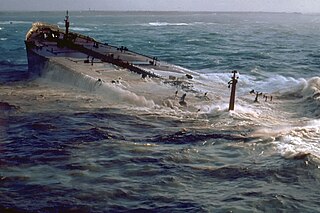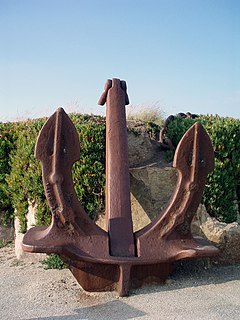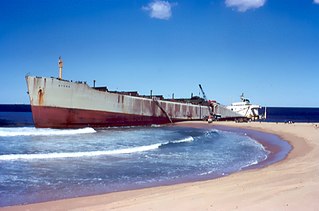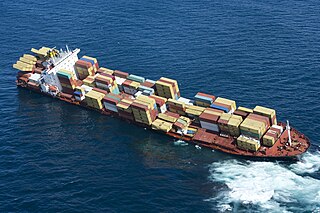The Tasman Spirit was a Greek registered oil tanker. The tanker was launched in February 1979 and was formerly called the Mabini and Kenko.

Amoco Cadiz was a VLCC owned by Amoco Transport Corp and transporting crude oil for Shell Oil. Operating under the Liberian flag of convenience, she ran aground on 16 March 1978 on Portsall Rocks, 2 km (1.2 mi) from the coast of Brittany, France. Ultimately she split in three and sank, resulting in the largest oil spill of its kind in history to that date.

Kawasaki Kisen Kaisha, Ltd. is a Japanese transportation company. It owns a fleet that includes dry cargo ships, container ships, liquefied natural gas carriers, Ro-Ro ships, tankers, and container terminals. It is the fourteenth largest container transportation and shipping company in the world.

The Aegean Sea tanker oil spill was a spill that occurred on 3 December 1992 when the double-bottomed Greek-flagged oil tanker, Aegean Sea, en route to the Repsol refinery in A Coruña, Spain, suffered an accident off the Galician coast. The ship had successfully passed all required tests and revisions. The accident occurred during extreme weather conditions and affected the Galician coast resulting in ecosystem damage, as well as damage to the fishing and tourist industries in A Coruña. The captain and pilot were found to be criminally liable and the shipowner took on much of the monetary liability.
The MV Sea Empress was a single-hull Suezmax oil tanker that ran aground at the entrance to the Milford Haven harbour on the southwest coast of Wales in February 1996. The ensuing oil spill, Britain's third largest oil spillage and the 12th largest in the world at the time, devastated a considerable area of local coastline and killed many birds, and continued to affect the Pembrokeshire coast for years afterwards.

MV Argo Merchant was a Liberian-flagged oil tanker built by Howaldtswerke in Hamburg, Germany, in 1953, most noted for running aground and subsequent sinking southeast of Nantucket Island, Massachusetts, causing one of the largest marine oil spills in history. Throughout the vessel's troubled past, she was involved in more than a dozen major shipping incidents including two other groundings; once in Indonesia while named Permina Samudra III, and again in Sicily while named Vari; and a collision in Japan.

MV Sygna was a Norwegian bulk carrier built by Austin & Pickersgill for J. Ludwig Mowinckels Rederi in 1967. It ran aground on Stockton Beach in Australia during a major storm in 1974. After its bow section was refloated, its stern remained beached and became an icon and landmark for the local area, until the visible remains of the wreck collapsed into the sea in 2016.

MV Xanthea, previously known as MV Drake, previously known as Pasha Bulker, is a Panamax bulk carrier of 76,741 tonnes deadweight (DWT) operated by the Lauritzen Bulkers shipping company and owned by Japanese Disponent Owners. While waiting in the open ocean outside the harbour to load coal, Pasha Bulker ran aground during a major storm on 8 June 2007 on Nobbys Beach in Newcastle, New South Wales, Australia. It was refloated and moved to a safe location offshore on 2 July 2007 at 9:48 p.m. AEST before being towed to Japan for major repairs on 26 July 2007.

The 2009 southeast Queensland oil spill occurred off the coast of southeast Queensland, Australia on 11 March 2009, when 230 tonnes of fuel oil, 30 tonnes of other fuel and 31 shipping containers containing 620 tonnes of ammonium nitrate spilled into the Coral Sea, north of Moreton Bay during Cyclone Hamish. It happened after unsecured cargo on MV Pacific Adventurer damaged other cargo, causing the spillage. Over the following days, the spill washed ashore along 60 kilometres (37 mi) of coastline encompassing the Sunshine Coast, Moreton Bay, Bribie Island and Moreton Island.
Katina P was a Greek oil tanker carrying 72,000 tonnes of oil which sank off the Mozambique coast on 26 April 1992.

The 2010 Great Barrier Reef oil spill occurred on 3 April 2010, when the Chinese bulk coal carrier, MV Shen Neng 1 ran aground east of Rockhampton in Central Queensland, Australia. The vessel is owned by Shenzhen Energy Transport Co. Ltd.

MV Rena was a 3,351 TEU container ship owned by the Greek shipping company Costamare Inc. through one of its subsidiaries, Daina Shipping Co. The ship was built in 1990 as ZIM America for the Israeli shipping company Zim by Howaldtswerke-Deutsche Werft AG in Kiel, Germany. She was renamed Andaman Sea in 2007 and had sailed under her current name and owner since 2010.

The Rena oil spill occurred off the coast of Tauranga, New Zealand in October 2011. The spill was caused by the grounding of MV Rena on the Astrolabe Reef. The Rena was a container ship and cargo vessel owned by the Greek shipping company Costamare Inc., through one of its subsidiary companies Daina Shipping. The spill has been described as New Zealand's worst maritime environmental disaster.

The Amoco Cadiz oil spill took place on 16 March 1978, when the oil tanker Amoco Cadiz, owned by the American petroleum company Amoco, ran aground on Portsall Rocks, 2 km (1.2 mi) from the coast of Brittany, France. The vessel ultimately split in three and sank. The US National Oceanic and Atmospheric Administration (NOAA) estimates that the total oil spill amounted to 220,880 metric tonnes of oil which amounts to over 58 million gallons or 256.2 million litres, making it the largest oil spill of its kind at the time.
The SS Wafra oil spill occurred on 27 February 1971, when SS Wafra, an oil tanker, ran aground while under tow near Cape Agulhas, South Africa. Approximately 200,000 barrels of crude oil were leaked into the ocean. The larger part of the ship was refloated, towed out to sea, and then sunk by the South African Air Force to prevent further oil contamination of the coastline.
This is a list of notable events relating to the environment in 2009. They relate to environmental law, conservation, environmentalism and environmental issues.
The SS Arrow was an oil tanker built by Bethlehem Steel Company, Sparrows Point, Baltimore, Maryland in 1948 as the tanker Olympic Games. Renamed Sea Robin in 1960 and finally Arrow in 1962, the ship was a Liberian-registered tanker owned by the Sun Navigation Company. At 551.2 feet in length and 68.3 feet in width, with a draft of 29.9 feet, she was an enlarged version of the standard American World War II tanker design and one of the oldest tankers in the fleet of Aristotle Onassis. The Arrow ran aground and spilled its load of oil into Chedabucto Bay on February 4, 1970. This remains the most significant oil spill off Canada’s East Coast, with some 10,000 tonnes. Only the MV Kurdistan accident has come close, spilling about 6,000 tons of oil after breaking apart in the Cabot Strait on March 15, 1979.
The Sanchioil tanker collision occurred on 6 January 2018 when the Panamanian-flagged, Iranian-owned tanker Sanchi, with a full natural-gas condensate cargo of 136,000 tonnes, sailing from Iran to South Korea, collided with the Hong Kong-flagged cargo ship CF Crystal 160 nautical miles (300 km) off Shanghai, China. Sanchi caught fire shortly after the collision; after burning and drifting for over a week, it sank on 14 January.
The Tasman Spirit oil spill occurred in the Arabian Sea just outside the Port of Karachi, Karachi, Pakistan on July 27, 2003, when Tasman Spirit, an oil tanker owned by Maltese company Assimina Maritime, bound for the Port of Karachi, Karachi from Kharg Island, Iran, ran aground while navigating to the Port of Karachi, at the Clifton Beach, at 12:57 p.m. local time and spilled approximately 30,000 metric tonnes of light crude oil over the next few days. It is considered to be one of the worst human-caused environmental disasters in Pakistan. The Tasman Spirit spill is The oil, originally extracted from oil fields in Iran, eventually affected 16 kilometres (9.9 mi) of the main public beach of the city, and the Port of Karachi, which were heavily or moderately oiled.

The MV Wakashio oil spill occurred after the Japanese bulk carrier Wakashio ran aground on a coral reef on 25 July 2020 at around 16:00 UTC. The ship began to leak fuel oil in the following weeks, and broke apart in mid August. Although much of the oil on board Wakashio was pumped out before she broke in half, an estimated 1,000 tonnes of oil spilled into the ocean in what was called by some scientists the worst environmental disaster ever in Mauritius. Two weeks after the incident, the Mauritian government declared the incident a national emergency.











